May 4 - 10, 2014: Issue 161
From Telegraphs to Telephones - For All Ships at Sea and Those On Land
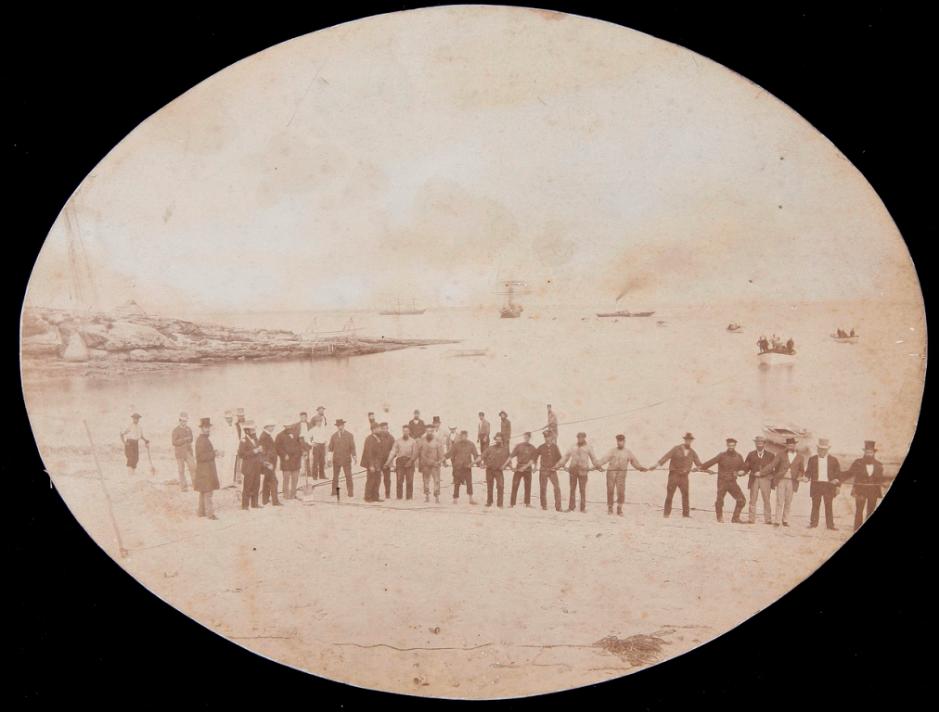
Landing of the New Zealand to Sydney telegraph cable at La Perouse in 1876
Oval black and white photograph of the landing of the New Zealand to Sydney telegraph cable at La Perouse in 1876. Photographer unknown. It shows a line of men on the beach, hauling the cable in. A paddle steamer and the two cable laying sailing ships EDINBURGH and HIBERNIA are lying offshore. On the reverse is handwritten "Landing of Sy NZ Cable/ La Perouse Waka/ 1876/ Edinburgh- Hibernia". Also present are blue coloured pencil annotations. The word "waka" written on the back was the call sign used by the Cable Bay station in New Zealand. Courtesy of the Australian National Maritime Museum. Also in State Library of NSW online photographic collection.
Communications In Pittwater: From Telegraphs to Telephones - For All Ships at Sea and Those On Land
A Telegraph apparatus was established at Barrenjoey in the Customs Station in 1869, the first Telegraph Officer being Customs (waiter) Officer Albert Thomas Black - it's main purpose being, as stated then, "to record and report shipping entering or leaving the Hawkesbury Pittwater - and report any wrecks", as well as keep an eye out for any potential smugglers, although these had been curtailed since the establishment of the Customs Station. Many of the reports from Barrenjoey also referred to weather conditions - listing vessels in Pittwater and staying there for shelter
A constant theme in many of the documents now accessible through National Australian Archives (search 'Barrenjoey') is that of the non-profitability of the Telegraph Office at the headland. What is also obvious is a maritime road instead of an earth one being utilised, with the Central Coast receiving communication connections a decade prior to communities further south in the estuary. Edward Charles Cracknell (see Extras), the gentleman in charge of Telegraph establishment in New South Wales, was determined to link all isolated areas of our coasts - going and gone were the days of waiting days for news. With the Light Keepers and Customs Officers duties taking up so much of their time their wives and children fulfilled the duties of postal and telegraphic work - records of letters indicating the position passing from one lady to the next. Kate Black fulfilling this role at Barrenjoey for a few years after her husband passed away. :
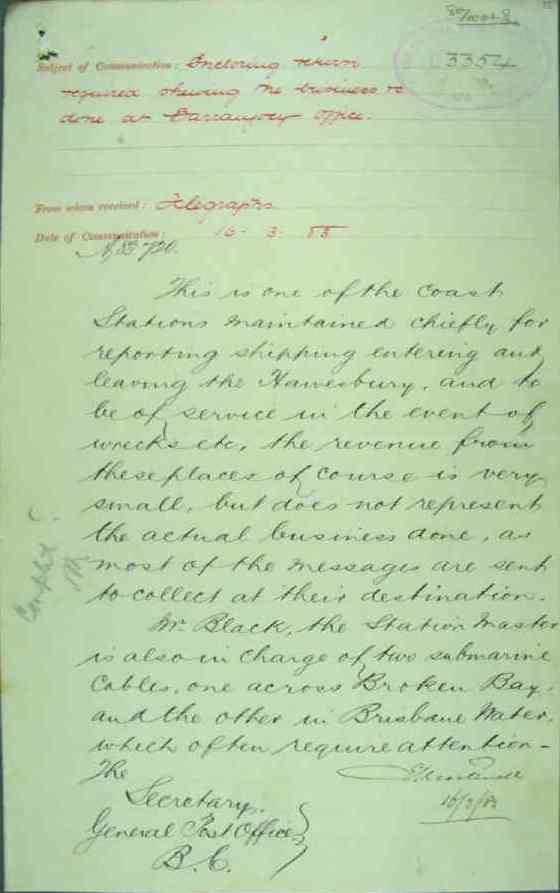 Country and Mining News. (FROM OUR CORRESPONDENTS.)BRISBANE WATER. July 23. The event of the week has been the opening of a telegraph station
at Gosford. The sudden and unexpected visit of Mr.E. C. Cracknell,
superintendent of telegraphs, to Gosford, on Monday last, put the whole township
in motion, as if an electric shock had been administered to the residents, who
woke up, as if by magic, from their usual lethargy, when it became known that
they were in instantaneous communication with Sydney and the rest of the world.
Some innocents stood gazing at the wire, expecting to see the pieces of paper
with the messages pass along it; others declaring that they heard the message go
along like thunder and lightning; others bewailed the fate of any of the Blue
Mountain parrots(at present so numerous in the district) that might have the
misfortune to take a moment's rest on the wire. Well, we have got the wire at
any rate, through the persevering application of Mr. Cunneen, late member for
the district. From all I can learn, the line from Wallsend here has been one of
the most difficult in the colony to construct. It is well for the country that
the contract was in the hands of so energetic a contractor as Mr. Thomas Smith,
of Maitland; many another man would have broken down under the task. The
selection of a site was but the work of a very short time. No site could have
been more aptly chosen than the one selected by Mr. Cracknell. The office is
situated in a store and dwelling occupied by Mr. Alfred Jaques, and amidst the
public offices and the principal business establishments in Gosford West. The
establishment is in charge of Mr. Goodman. It may be well to mention, for the
information of your very numerous readers in this district, that messages are
delivered free of charge within a radius of one mile of the station; for the
first mile after, a charge of 6d is made, and the charge for every mile beyond
is discretionary with the stationmaster. The charge for transmitting a message
to any part of the colony is 1s for the first ten words, and 2d for every
additional word. I have heard that it is the intention of the
Postmaster-General to extend communication by laying a cable hence through
Broadwater and Broken Bay to Barrenjoey, thus facilitating the transmission of
messages between Sydney, Wallsend, Newcastle and the northern districts
generally. Country and Mining News.
(1878, July 27). Australian Town and Country
Journal (NSW : 1870 - 1907), p. 38.
Retrieved from http://nla.gov.au/nla.news-article70593495
Country and Mining News. (FROM OUR CORRESPONDENTS.)BRISBANE WATER. July 23. The event of the week has been the opening of a telegraph station
at Gosford. The sudden and unexpected visit of Mr.E. C. Cracknell,
superintendent of telegraphs, to Gosford, on Monday last, put the whole township
in motion, as if an electric shock had been administered to the residents, who
woke up, as if by magic, from their usual lethargy, when it became known that
they were in instantaneous communication with Sydney and the rest of the world.
Some innocents stood gazing at the wire, expecting to see the pieces of paper
with the messages pass along it; others declaring that they heard the message go
along like thunder and lightning; others bewailed the fate of any of the Blue
Mountain parrots(at present so numerous in the district) that might have the
misfortune to take a moment's rest on the wire. Well, we have got the wire at
any rate, through the persevering application of Mr. Cunneen, late member for
the district. From all I can learn, the line from Wallsend here has been one of
the most difficult in the colony to construct. It is well for the country that
the contract was in the hands of so energetic a contractor as Mr. Thomas Smith,
of Maitland; many another man would have broken down under the task. The
selection of a site was but the work of a very short time. No site could have
been more aptly chosen than the one selected by Mr. Cracknell. The office is
situated in a store and dwelling occupied by Mr. Alfred Jaques, and amidst the
public offices and the principal business establishments in Gosford West. The
establishment is in charge of Mr. Goodman. It may be well to mention, for the
information of your very numerous readers in this district, that messages are
delivered free of charge within a radius of one mile of the station; for the
first mile after, a charge of 6d is made, and the charge for every mile beyond
is discretionary with the stationmaster. The charge for transmitting a message
to any part of the colony is 1s for the first ten words, and 2d for every
additional word. I have heard that it is the intention of the
Postmaster-General to extend communication by laying a cable hence through
Broadwater and Broken Bay to Barrenjoey, thus facilitating the transmission of
messages between Sydney, Wallsend, Newcastle and the northern districts
generally. Country and Mining News.
(1878, July 27). Australian Town and Country
Journal (NSW : 1870 - 1907), p. 38.
Retrieved from http://nla.gov.au/nla.news-article70593495
Newport's office opened two years prior to one being officially opened at Bondi! :
Newport Telegraph Office. Last Saturday the new telegraphic office at Newport was formally opened by Mr. Cracknell, the chief superintendent, in the presence of a large assemblage of residents and visitors. Mr. Cracknell delivered a short address, and formally declared the office opened and communication established with the rest of the world. He asked the visitors to join with him in thanking Messrs. Shorter and Boulton for the efforts they had made in bringing about this desirable result. A large number of ladies and gentlemen then adjourned to Bulfin's Newport Hotel, where dinner was provided for those who had taken a prominent part in the proceedings. This opportunity was taken to present the Christmas prizes at the Newport public school, which has been open for about nine months, and is under the supervision of Miss Giles. Various prominent residents had contributed to the prizes, amongst which was a watch, donated by Mr. Aitken to the most efficient pupil. After the prizes had been distributed, an address, signed by the Misses Bulfin and Miss M. Scott, on behalf of their fellow pupils, was presented to Miss Giles. The address was accompanied by a gold-bracelet and a smelling-bottle. The presentation was suitably acknowledged by Miss Giles, after which, the proceedings terminated. Newport Telegraph Office. (1888, December 27). Evening News (Sydney, NSW : 1869 - 1931), p. 8. Retrieved from http://nla.gov.au/nla.news-article108111373
What came so soon on top of Telegraphs was the invention of Telephones, demonstrated to work in 1876 by Alexander Bell - and in Sydney by 1881
The Bay View Post-office, with a telephone, is attached to a store in front of his grounds. The various industries that Mr. and Mrs. Roche successfully conduct are worthy of praise and admiration. There is also a post and telegraph office at Newport, so that in the matter of postal, telegraphic, and telephonic communication Pittwater is up to date. Religion and education are amply provided for at Pittwater. Most of the denominations have places of Divine worship there. There are two Catholic churches, one at Josephton, Careel Bay, and the other at Mona Vale, which are served by the Rev. Father Dowling, or one of the priests attached to St. Patrick's College, Manly. There is a Public school at Bay View, and one also at Newport. A SKETCH OF PITTWATER. (1898, May 7). Freeman's Journal(Sydney, NSW : 1850 - 1932), p. 20. Retrieved from http://nla.gov.au/nla.news-article115386531
Telephone bureaux have been established at Brookvale, Narrabeen, and Newport. The charges are as follow :—Brookvale : For each period of three minutes, or portion thereof, 6d. Narrabeen:For each period of three minutes or portion thereof,6d. Newport : For each period of three minutes or portion thereof, 1s. THE PRINCE ALFRED HOSPITAL. (1901, March 6). The Sydney Morning Herald (NSW : 1842 - 1954), p. 6. Retrieved from http://nla.gov.au/nla.news-article14346660
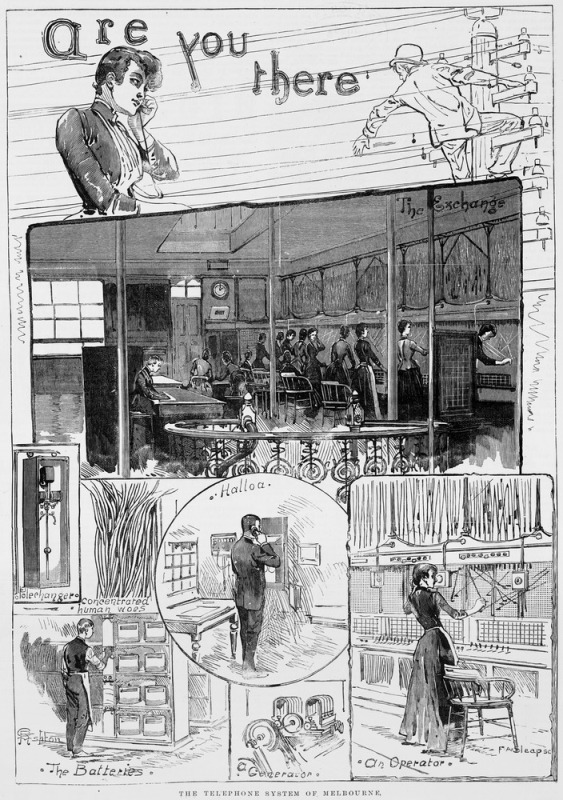
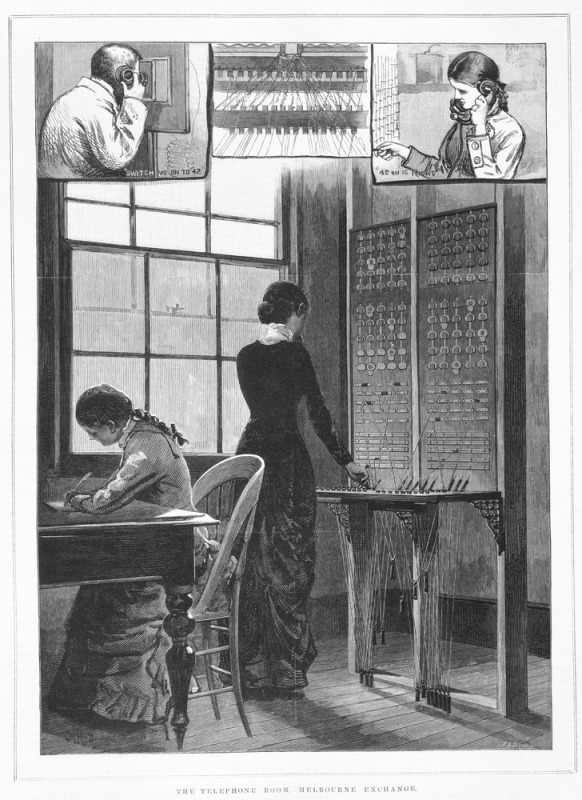
THE TELEPHONE SYSTEM OF MELBOURNE [VIC.] Date(s): September 1, 1890, from Illustrated Australian news: Monogram of George Rossi Ashton engraved in image ; woodcut engraving
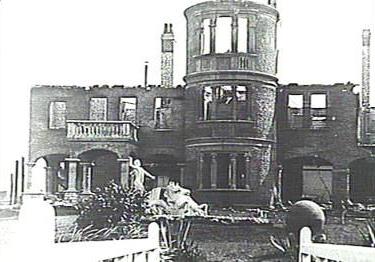 BIG FIRE AT MONA VALE, THIRTY BOARDERS ESCAPE IN NIGHT- ATTIRE. - .DAMAGE
ESTIMATED. AT £30,000. SYDNEY, Monday A disastrous conflagration, the
resulting damage of which is estimated at £30,000, early this morning destroyed
Brock's Mansions at Mona Vale, 20 miles from Sydney, and 14 miles from Manly.
The premises were conducted as an extensive boarding house by Madame Reineud,
who shortly before the 1am woke out of her sleep to find the place on fire-
She-aroused her boarders, some 30 in number, all of whom were compelled to fly
from their rooms in their night attire, having no time to take either their
clothes or jewellery with them. The boarders were barely out of the place when
the building was a roaring mass of flames. One of the boarders motored to
Manly, but the fire brigade refused to proceed to Mona Vale, as there was no
reticulation service and as it was not in the brigade's district. The fire burnt
itself out, leaving nothing but a mass of ruins. The fire is supposed to have
been caused by the burning butt of a cigar having been carelessly thrown on the
dining-room carpet.
BIG FIRE AT MONA VALE, THIRTY BOARDERS ESCAPE IN NIGHT- ATTIRE. - .DAMAGE
ESTIMATED. AT £30,000. SYDNEY, Monday A disastrous conflagration, the
resulting damage of which is estimated at £30,000, early this morning destroyed
Brock's Mansions at Mona Vale, 20 miles from Sydney, and 14 miles from Manly.
The premises were conducted as an extensive boarding house by Madame Reineud,
who shortly before the 1am woke out of her sleep to find the place on fire-
She-aroused her boarders, some 30 in number, all of whom were compelled to fly
from their rooms in their night attire, having no time to take either their
clothes or jewellery with them. The boarders were barely out of the place when
the building was a roaring mass of flames. One of the boarders motored to
Manly, but the fire brigade refused to proceed to Mona Vale, as there was no
reticulation service and as it was not in the brigade's district. The fire burnt
itself out, leaving nothing but a mass of ruins. The fire is supposed to have
been caused by the burning butt of a cigar having been carelessly thrown on the
dining-room carpet.
One of the boarders tore the telephone from the wall and carried it outside. Later in the day an electrician fitted the instrument to a fence. The boarders were thus enabled to telephone to their friends and arrange for a supply of clothing. Accommodation was provided for the homeless people at Mr. Scott Fell’s house. Madame Reineud lost about £10,000.worth of furniture and fittings. The building was owned by Mr. Arthur Rickard. The total damage is estimated at over £30,000. The building, when constructed some years ago, cost £30-000. It possessed its own polo ground and racecourse, the latter afterwards bang converted into golf links. BIG FIRE AT MONA VALE. (1912, January 9). The Border Morning Mail and Riverina Times (Albury, NSW : 1903 - 1920), p. 3. Retrieved from http://nla.gov.au/nla.news-article109730918
1904: The Telegraph Office was closed at Barrenjoey. There are several records, again in National Archives of Australia, of exchanges in arranging to pick up this telegraphic equipment. A Telephone was installed and line to main exchange at Manly was established. Like the telegraph apparatus - many of the first telephones within Pittwater were part of the general stores - at Church Point, Bayview, Newport, Mona Vale - with some establishments having their own, as 'The Oaks' did - prior to the night it was destroyed.
TRUNK- TELEPHONE SERVICES. The Postmaster-General's Department announces that an improved system of operating trunk lines to Blackheath, Bowral, Campbelltown, Corrimal. Cronulla, Glenbrook, Katoomba, Kurnell, Lawson, Lithgow, Mittagong, Mona Vale. Palm Beach, Penrith, Port Kembla, Sutherland, Thirroul, Wentworth Falls, Windsor, and Wollongong exchanges will be introduced on Monday, September 17. Subscribers will obtain service with these exchanges by calling 13076, when, as far as practicable, calls will be completed on demand. TRUNK TELEPHONE SERVICES. (1928, September 15). The Sydney Morning Herald (NSW : 1842 - 1954), p. 22. Retrieved from http://nla.gov.au/nla.news-article16494525
In the UK and the Commonwealth countries, a trunk call was a long distance one as opposed to a local call. Trunking also referred to the connection of switches and circuits within a telephone exchange, allowing a group of inlet switches at the same time. Thus the service provider can provide a lesser number of circuits than might otherwise be required, allowing many users to "share" a smaller number of connections and achieve capacity savings.
MONA VALE TELEPHONES. Mr. J. W. Kitto, Deputy-Director of Posts and Telegraphs, advises that from 10 a.m. on Monday next subscribers connected to automatic exchanges will obtain service direct with Mona Vale by calling Y04, Instead of B070, as at present. Subscribers on manual exchanges should ask the local exchange for the Mona Vale number. MONA VALE TELEPHONES. (1930, February 15). The Sydney Morning Herald (NSW : 1842 - 1954), p. 12. Retrieved from http://nla.gov.au/nla.news-article28045043
Avalon Post Office proposal by Warringah Shire Council(from Council Minutes of Meetings): 13/3/1933: P.M.G. 'S 'Dept.1/3/33,: inquiring whether Council desires to express any wish in connection with a natal name for the proposed post Office at Avalon Beach. Resolved, The Department be recommended to adopt the name "Therry”. - (Crs., Hitchcock, Austin) .
The Commonwealth Department of the Interior Work- and Services Branch has made the following orders on tenders recently received : Mona Vale, Erection of automatic telephone exchange building tender accepted, S J Campbell 11 Hunter street Mortdale, £1040. GOVERNMENT CONTRACTS. (1934, July 17). The Sydney Morning Herald (NSW : 1842 - 1954), p. 6. Retrieved from http://nla.gov.au/nla.news-article17089329
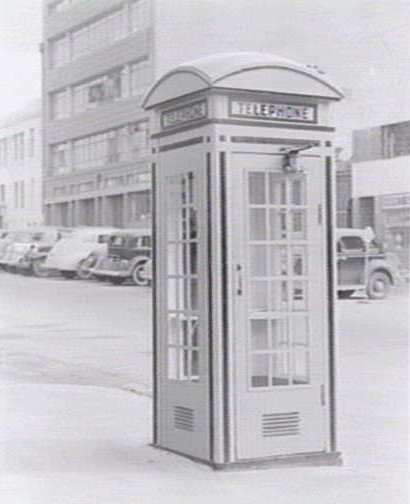 MONA VALE TELEPHONE. The telephone exchange at
Mona Vale will be converted to automatic working on Tuesday December 18 at 7
am. MONA VALE TELEPHONE. (1934, December 18). The Sydney
Morning Herald (NSW : 1842 - 1954), p. 7. Retrieved from http://nla.gov.au/nla.news-article17128140
MONA VALE TELEPHONE. The telephone exchange at
Mona Vale will be converted to automatic working on Tuesday December 18 at 7
am. MONA VALE TELEPHONE. (1934, December 18). The Sydney
Morning Herald (NSW : 1842 - 1954), p. 7. Retrieved from http://nla.gov.au/nla.news-article17128140
What is interesting about these Tenders and their dates is Mr William 'Billy' Hughes, who had a holiday cottage at Palm Beach since at lesst 1923, requested Mr Kitto install a telephone box at this same place for 'privacy' in 1934, and within weeks, one magically appeared.
Telephone box - ca. 1938-ca. 1940, photo by Lyle Fowler, Courtesy state library of Victoria, Image No:a18211
J McKay £51/10/ Mona Vale Telephone Exchange External painting Lowest tender received. BUILDING AND CONSTRUCTION. (1938, February 1). The Sydney Morning Herald (NSW : 1842 - 1954), p. 6. Retrieved from http://nla.gov.au/nla.news-article17424454
NORTH SYDNEY TELEPHONE. Automatic To-morrow. The new telephone exchange at North Sydney will be changed over to complete automatic working at 5.30 p.m. to-morrow, at which time, the call letters for practically all the North Shore and Manly systems will come into use. Telephones connected with the North Sydney exchange are divided into four groups-North Sydney (XB), Cremorne (XA), North-bridge (XL), and St. Leonards (XF).Changes are made In other call letters. Mosman becomes XM, Manly XU, Deewhy XW8,Mona Vale XW9, and Chatswood JA. These changes affect 26,360 subscribers. There has been a big increase in the number of persons in the districts named using the telephone. Ten years ago the subscribers totalled 18,754. The increase in the intervening period has been almost 8,000, or about 45 per cent. NORTH SYDNEY TELEPHONE. (1938, May 27). The Sydney Morning Herald (NSW : 1842 - 1954), p. 15. Retrieved from http://nla.gov.au/nla.news-article17468730
LIGHTNING FLASH. Men Struck at Warriewood. TREE SPLINTERED. Three men were slightly Injured by a flash of lightning, which struck a tree at Warriewood, near Mona Vale, on Friday. Mr. D. McLaren was clearing debris from his garden in Hill-street, and Mr. J. Skinner was watching him from a nearby house. Both men were almost blinded by a vivid flash when lightning struck a tall gum tree about 70 yards from Mr. McLaren. Every bough except one was hurled from the tree by the force of the explosion, and pieces of bark were thrown hundreds of feet in all directions. One bough, 4ft in length, was tossed 100 yards, where it struck the chimney of a cottage. Windows in neighbouring houses were shattered. Mr. McLaren, dazed and paralysed in one side, was able to reach Mr Tarry’s home, a neighbour's house, where he collapsed. He was treated, and suffered no ill-effects.
James Savage and Hermann Schrelnerp were working at the switchboard of the Mona Vale post-office, when their instruments were struck by a blinding flash. The two men were stunned, and when they recovered were almost helpless for some time. Then they returned to duty, to find that a number of lines had been rendered useless by the disturbance. Patrolling Mona Road, Constable Langhurst received a severe shock in the right arm, but was able to resume duty.LIGHTNING FLASH. (1931, April 27). The Sydney Morning Herald (NSW : 1842 - 1954), p. 6. Retrieved from http://nla.gov.au/nla.news-article16772870
Houses Rocked by Fireball. One man was temporarily paralyzed; two telephonists and a constable were struck by lightening; houses rocked and windows shattered when yesterday a fireball, exploding in a tree, smashed against an earth embankment near Mona Vale, says the Sydney Daily Telegraph. Lighting the district for miles, the flaming missile crashed into a tall tree in Hill Street, Warriewood, near Mona Vale. There was instant confusion and terror-the tree splintered and smashed to the ground, and the fireball finished against a nearby embankment. Parts of the tree were hurled over 100 yards.
As the glare died away Mr. D. McLaren, dazed and paralyzed in one side, stumbled from his house in Hill Street, where he had been clearing away storm debis, to Mr Tarry's home nearby. There he collapsed. He was revived later by Dr. Bruce.
Meanwhile at Mona Vale Post Office, telephonists Hermann Schrelnerp and James Savage had been struck while at their switches. They soon recovered to find that six local and five trunk lines had put out of action. Patrolling Mona Road, Constable Langhurst received a severe shock in the right arm, but was able to resume duty. Houses Rocked by Fireball. (1931, May 1). The Charleville Times (Brisbane, Qld. : 1896 - 1954), p. 2. Retrieved from http://nla.gov.au/nla.news-article75686553
Pittwater residents who remember telephones arriving in Pittwater also recall that not too many people had them to begin with - they were too expensive for most and it was primarily businesses that had these installed.
Clarence plunged into the breakers and swam out to his father's assistance. His effort was unsuccessful for he failed to locate his father. After being in the water for about 10 minutes Clarence became exhausted and signalled to his brother, Douglas, who held the line, to haul him ashore. Douglas had no sooner started to do so than the line snapped. Clarence immediately sank and neither he nor his father were seen again. Search for the bodies was continued through-out the day.
Meanwhile a telephone message had been sent to Mr. W. Goddard at Palm Beach. He immediately put to sea in a launch and searched the vicinity. No trace of the victims could be found. A pair of trousers and a shirt were picked up in the water, but the seare believed to have belonged to Clarence Mitchell who, before plunging Into the surf, had discarded his clothing. The scene of the tragedy is the same as that at which a drowning took place a few months ago. TWO MEN DROWNED. (1933, July 3). The Sydney Morning Herald (NSW : 1842 - 1954), p. 9. Retrieved from http://nla.gov.au/nla.news-article16987887
WWII: The 18th Battalion which were stationed on Barrenjoey Headland used to report in from a telephone at the Beacon Store (opposite Barrenjoey Boatshed) -
Telegraph and Telephone. W.T.J.: (Mona Vale): (1) Telegraphing's one thing and telephoning is another. The telegraph service can transmit the communications of a large number of people at one time, and might, therefore, be regarded as an omnibus communication service. (2) Before and many years after the advent of wireless as a means of communication, it could not be used in a practical manner for telephone or voice communication. This developed later, but was regarded as having a very limited range. Australia kept abreast of this development with other countries, and, by means of steady research and the manufacture of the necessary equipment in Australia, succeeded in establishing the first public wireless telephone service between a British Dominion and the old country. Queries? Answers. (1941, January 23). The Catholic Press(Sydney, NSW : 1895 - 1942), p. 2. Retrieved from http://nla.gov.au/nla.news-article106423944
Injured Soldier Crawled To Telephone.
With a compound fracture of his right leg. a soldier who had fallen from the roof of his house yesterday dragged himself indoors and telephoned for help. The soldier. Pte. T. R. Hillier, of Pacific Street. Palm Beach, was painting the roof of his house when he lost his balance on the ladder and fell about 12ft to the ground. His calls for help were not heard, and, almost fainting, he dragged himself into the house to the telephone. He was forced to rest many times before reaching the telephone. He called the postmistress at Palm Beach, Mrs. R. Williams. She rang Manly Ambulance, and Hillier was taken to an Army hospital. He was suffering from shock when he was admitted. Injured Soldier Crawled To Telephone. (1944, October 28). The Sydney Morning Herald (NSW : 1842 - 1954), p. 4. Retrieved from http://nla.gov.au/nla.news-article17925685
MOTHER UNABLE TO RAISE EXCHANGE. Son Injured Seriously in Cycle Crash SYDNEY, Monday.
For an hour this evening Mrs Legallion, of Iluka Road, Palm Beach, attempted to raise the Palm Beach telephone exchange so that she could summon the Manly ambulance to at-tend to her son, Charles, 14, who had been injured seriously in a fall from a bicycle. Finally in desperation she ran to the home of Dr Brown, who drove a mile to the exchange and returned with an ambulance. The boy was admitted to Manly District Hospital suffering from a lacerated 'scalp, serious abrasions to arms, severe shock and fractured ribs.
He was returning from school on a bicycle when he was forced off the road by a passing motorist. The lad skidded along the gravel, tearing the skin on practically the whole of the left side of his body When he had not returned from school his mother went to look for him and he was found unconscious, some distance from the cycle. Officials of the Postal Department stated to night that investigations would be made into the delay in raising the exchange. MOTHER UNABLE TO RAISE EXCHANGE. (1945, October 30).The Canberra Times (ACT : 1926 - 1995), p. 4. Retrieved from http://nla.gov.au/nla.news-article2649831
INJURED BOY'S LONG WAIT ON ROADWAY. After falling from his bicycle in Florida Road, Palm Beach, last night, a boy of 14 lay on the roadway, seriously injured, for an hour while vain efforts were made to raise the local manual telephone exchange to summon the Manly Ambulance. Dr, Brown, of Palm Beach, rendered temporary medical aid to the injured boy. Charles Le Gallion, of lluka Road. Palm Beach, and then joined in efforts to contact the exchange. All attempts made from two telephones in the vicinity having failed, a car was sent to the exchange and an ambulance from the Manly depot, 31 miles away, arrived in less than half an hour,
The boy was admitted to Manly Hospital shortly after 8 p.m., nearly three hours after the accident, He sustained deep Incerations to the head and right shoulder, severe shook, andprobable fractured ribs.
Ants On Wounds. The driver of the ambulance, Mr C. Williams, said that when he arrived numerous ants were crawling over the boy's wounds. Mr. A. Mays, committee man and publicity officer of the Manly and Warringah District Ambulance, said last night that his committee had been trying for more than a year to get permisison to build an ambulance station on land which is owned at Mona Vale, but the applications had consistently been refused by the Government. A sub-station in that area would enable cases in the Palm Beach and Newport districts to be reached quickly. INJURED BOY'S LONG WAIT ON ROADWAY. (1945, October 30). The Sydney Morning Herald (NSW : 1842 - 1954), p. 3. Retrieved from http://nla.gov.au/nla.news-article17957947
The Car Radio - Telephone Is Coming Into Fashion By A STAFF CORRESPONDENT
Nearly 1,000 motor vehicles in Australia are now fitted with two-way radio telephone sets which enable their owners to talk to their city offices while travelling by road. These, new voices in the air will be multiplied when the Postal Department shortly opens its new public radio telephone service in Sydney and Melbourne, offering private motorists the facility of speaking from their cars to any telephone subscriber in Australia.
THE growing popularity of the astonishing mobile two-way radio set, made possible by the development of frequency modulation (F.M.),is filling the ether with many strange new voices which radio has not heard before. Ten years ago, tuning in on a high-frequency set, we might have heard ships at sea speaking to the shore, aircraft talking to the ground, and police cars calling headquarters. To these familiar voices are now added many more-brisk business like voices, urgent voices, excited voices, and voices that report dramatic events in tones so coldly unemotional they seem incongruous.
They come from some 250 public utility vehicles, yachts, and launches which have in the past two or three years been equipped for radio telephone communication. Turning a dial on an F.M. set it is possible to hear in the space of half an hour voices like these;
First Voice: "Are you there, Traffic Control? There's a bad jam up here. Send someone to straighten it out." (From a Road Transport and Tramways Department car, passing King's Cross, to departmental headquarters in Macquarie Street.)
Second Voice: "Proceed to Lidcombe on your way back. Transformer fault in Railway Street. Twenty shops blacked out." (From Sydney County Council transmitter to electrical service truck travelling to Parramatta.)
Third Voice: "Shop manager shot dead in jewel robbery at 11.45 a.m. Masked assailant escaped in high-speed car pursued by passing motor-cyclist. Eyewitnesses say . . ."(Crime reporter's car reporting to newspaper office.)
Fourth Voice: "Hullo, Jimmy. I've just caught two more beauties. Tell mother it's fish for dinner." (From enthusiastic fisherman in launch off Sydney Heads.)
And there are others-messages from police cars, ambulances, fire brigade vehicles, Water Board repair trucks, and some 21 N.R.M.A. patrol vehicles servicing cars in trouble on our roads. A story is told of a citizen whose house was plunged in darkness one night. He walked down the street to the nearest public telephone box and rang the electric light people. When he got home he found the lights on again. His urgent summons had been passed on by two way radio to a repair gang working in a near-by street.
The ether is not yet overcrowded, but its traffic is getting busier everyday. At night it is filled with the voices of the "hams," the radio amateurs, 2,500 of them in Australia, who chatter away happily to likeminded enthusiasts in every country of the world.
There are the ships at sea, talking to themselves and to the shore, filling the air with nautical and meteorological data, and passengers talking to their homes on land from the comfort of their cabins-a busy conversational traffic which automatically ceases for three minutes twice every hour in obedience to international regulations requiring observance of the S.O.S. distress silence at sea (at 15 minutes to and 15minutes past each hour).
Already 10 per cent, of all ocean going sailing craft in Sydney have their own two-way radios and when the Postal Department's new service operates yachtsmen and launch owners will be able to ring up their homes and tell their wives when they will be back for dinner.
Used In Yacht Race
For two years now a service, believed to be unique in the world, has been given by the Royal Prince Alfred Yacht Club, which supplies a two-way radio set to every yacht competing in the Sydney-Montagu Island race. This remarkable service is regarded not only as a great convenience to competitors and race officials, but also as an invaluable safety measure.
All this began way back in 1922when Amalgamated Wireless (Australasia) Ltd. installed a wireless set in a police car cruising the streets of Melbourne. It is believed this was the first attempt anywhere' in the world to equip a motor vehicle with radio. In those days static and electrical noises interfered badly with reception, but with the development of frequency modulation during the war all that changed. The new F.M. equipment manufactured since 1945 gives quiet effortless telephone conversation even from a car travel-ling at 60 miles an hour.
First commercial use of the F.M. radio telephone in Australia was initiated by Melbourne wholesale tobacco merchants, Leo Hemingway and Sons, who in January last year fitted sets in their fleet of 32 vans. The installation saves precious travelling time. When one van runs short of a certain brand of tobacco the driver rings up head office and asks for fresh supplies. Head office at once contacts another van travel-ling in the vicinity. A few minutes later the two vans meet at an appointed rendezvous and stocks are adjusted at the roadside.
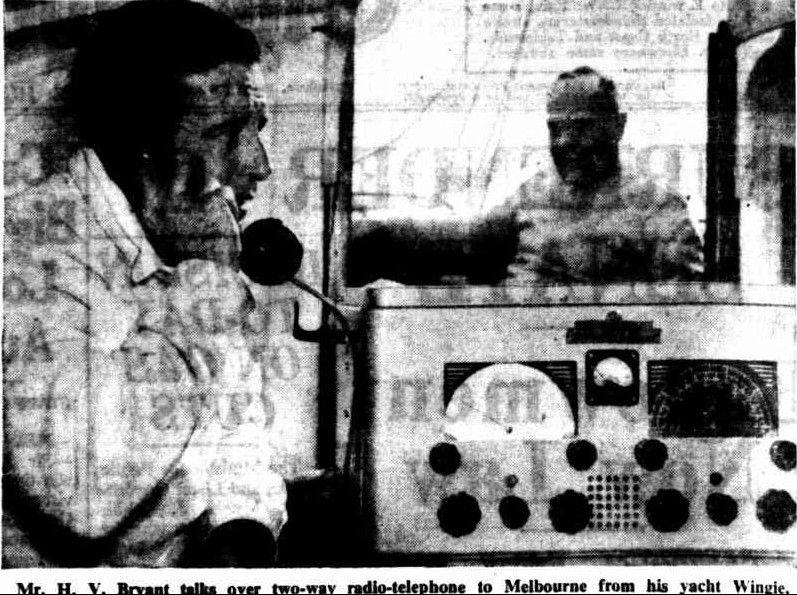
Mr. H. V. Bryant talks over two-way radio-telephone to Melbourne from his yacht Wingie, cruising off Sydney Heads. Mr. H. M. Lamb is at the tiller.
It requires little imagination to picture a vast extension of this kind of service. Already many Adelaide taxis are operating it much as they do m the United States, where no less than 75,000 cabs are fitted with two way radios. Not long ago an Adelaide woman telephoned for a taxi She had only just returned the telephone to its hook when a taxi-driver rang the door bell and said Did you call a cab, ma'am?" He had just deposited a fare next door when he had been rung up by radio and given the woman s address
Most remarkable of all modern two way communication gadgets is the tiny 4in cube containing wire-less transmitter and receiver designed by A W A for installation in air-craft It is so small it could fit in one's pocket. For the pivate motorist intrigued by the prospect of being able to pickup a telephone in his car and speak direct to his home, installation of the service may be costly When the Postal Department gets its new system started in the next few months and your calls can be switched into the ordinary telephone system it will cost you £80 to rent an instrument for your car, £51 a year for the service of special switchboards in the Post Office, and 6d for every three minute local call.
Because there will be only one speaking channel at the start, with every subscriber using a common frequency, delays may easily Occur before your call goes through. It will be something like using a party telephone line. At first the range of calls will be limited to within 20 miles of the aerials, for F M communication is restricted to the line of sight. So far the department Ins been able to install very few aerials 1 her is one on the roof of the Grace Building in York Street, others on … ground at Bexley, Collaroy and Vaucluse, but as more of them go up the range will lengthen and the popularity of the service is bound to grow, with corresponding benefits in cost. Perhaps in ten years time talking from your car to your home maybe as commonplace as talking from Sydney to Palm Beach. The Car Radio- Telephone Is Coming Into Fashion. (1950, June 23). The Sydney Morning Herald (NSW : 1842 - 1954), p. 2. Retrieved from http://nla.gov.au/nla.news-article18169949
Eight digits, no thumbs - SYDNEY: Austel announced yesterday that all Sydney telephone and facsimile numbers, and some pager numbers, beginning with "9" would change to eight digits next July. The notification of the number change is the second phase of all Sydney "02" numbers changing to eight digits. Phase one ended last week when numbers in the suburb of Mona Vale beginning with "99"changed to eight digits. Next July, a number such as 920 4321 will change to 9920 4321. Eight digits, no thumbs. (1994, August 6). The Canberra Times(ACT : 1926 - 1995), p. 2. Retrieved from http://nla.gov.au/nla.news-article118260725
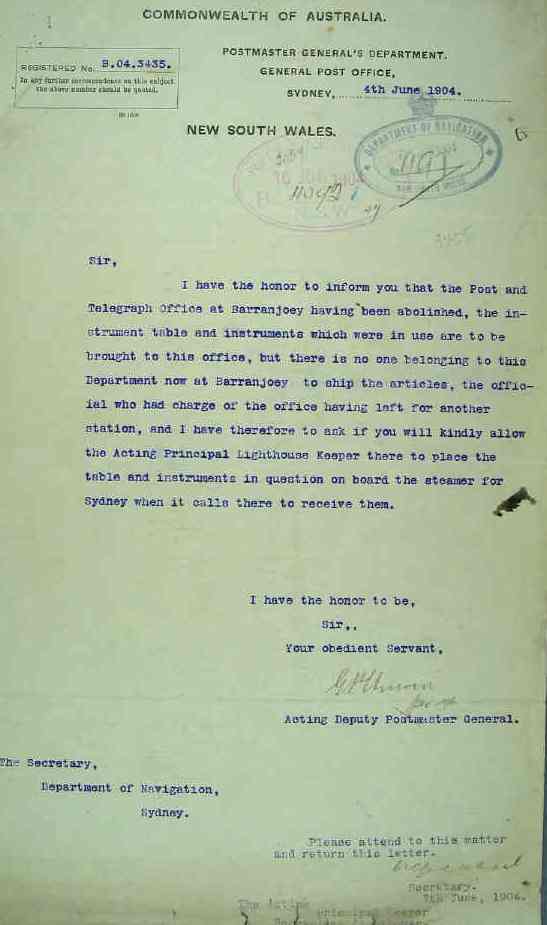
Extras:
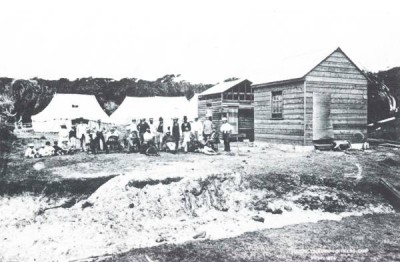 New South Wales
New South Wales
The New South Wales Government commenced construction of that states first telegraph line from Sydney to Liverpool a distance of 20 miles. The line opened on 30 December 1857. Edward Charles Cracknell was appointed Assistant Superintendent of Telegraphs in January 1858 and Superintendent in 1861. The Liverpool line was extended to Albury on the NSW/Victorian border a distance of 200 miles in October 1858. This line connected with a line from Melbourne thus linking the two Capitals. At this time Sydney – Melbourne and Adelaide became connected by Telegraph. In 1867 the first direct line linking Adelaide and Sydney was opened. The last Morse Code message on the eastern seaboard was sent between Bombala and Sydney in early 1963.
Australia was a relatively early adopter of telegraph technology in the middle nineteenth century, despite its low population densities and the difficult conditions sometimes encountered in laying lines. From 1858 onwards, the major capitals were progressively linked, culminating in the addition of Perth in 1877. Australia was linked to the rest of the world for the first time in 1872, through the Overland Telegraph which ran some 3200 km from Adelaide through to Darwin.
History of telegraphy in Australia. (2014, April 24). In Wikipedia, The Free Encyclopedia. Retrieved from http://en.wikipedia.org/w/index.php?title=History_of_telegraphy_in_Australia&oldid=605539500 - Photo: The Electric Telegraph Officer’s Camp: laying the cable, La Perouse, Botany Bay, 1876. Courtesy the State Library of New South Wales
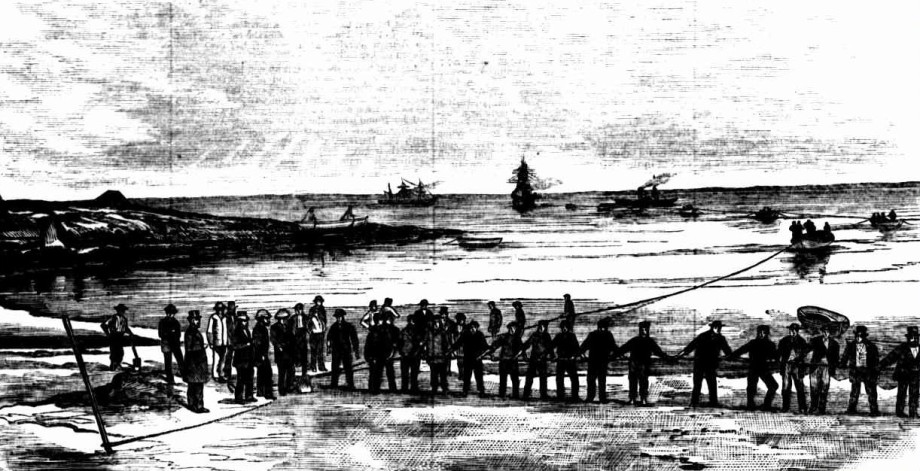
LAYING THE Shore end of the New Zealand cable at Botany Bay (engraving)
Submarine Cable from New South Wales to New Zealand.
AN event of the highest importance, in respect to the interests of intercolonial commerce, viz., the laying of the shore end of the cable, just below La Perouse monument, Botany Bay, New South Wales, to connect with Blind Bay, Nelson, and thence with the land lines of Now Zealand, took place on Saturday morning.
The spot chosen for the laying of the shore end of the cable possesses some historical interest. It is situated on the north side of Botany Bay, just within the entrance, directly opposite the place on the south HU1< of the bay where Captain Cook landed in April, 1770 A few days after the arrival of Captain Phillip and the first fleet January 18th, 1788, the celebrated French navigator, M. La Perouse, with two ships bearing French colours, entered the bay, having left Brest in August, 1785, and had during their voyage made some important discoveries. La Perouse established himself at this spot, in Botany Bay, for the purpose of completing two boats, which he had brought out in frame. An observatory sent, was also put up for the convenience of Monsieur D'Ajelet, the chief astronomer of the expedition. During the stay of the French ships the naturalist of the expedition, Father Receveur, died from the effects of wounds received in a conflict , with the natives of the Navigators Islands. A monument, with a suitable inscription, was erected to his memory. La Perouse sailed out of Botany Bay with his vessels, Astrolabe and Boussole, on the 10th March, 1788. Nothing definite was heard of La Perouse till the year 1826, when Captain Toter Dillon obtained information that the two vessels were wrecked on Malli i»lo, one of the New .Hebrides, and that the crow of one vessel had all been murdered or drowned, and that «orno of the crow of the other had built a boat and sailed away. Previous to the discovery of the articles belonging to the ship on the island, the French Government caused to be erected on the spot where La Perouse had parted from his English friends a monument-in the shape a picturesque lofty stone column to his memory.
The proceedings in laying the cable were exceedingly interesting. The cable steam-ship, Hibernia, Captain Cato, and the Edinburgh cable steam-ship. Captain Manning, left Port Jackson on Friday afternoon, and anchored in Botany at 5 p.m.
For some time past the officers connected with the expedition have been making the necessary preparations. Four tents and two weatherboard buildings, on stone foundations, for the accommodation of the cable offices, have been constructed immediately below the monument and thirty-five yards from the shores of the bay. In the principal of those weatherboard buildings, which is only 12 feet square, all the instruments are erected. There are four of Sir William Thompson's aesthetic mirror galvanometers, in addition to a speaking galvano meter, and one of Morse’s spare instruments.
At 6 a.m. the boats made ready, from the Hibernia, which was anchored one-third of a mile out. A great length of cable rope was stretched from the ship to the main land, 100 yards east of the place where the cable was to be landed. The life-boat, with the first portion of the cable on board followed, and the cable looped from seven other boats, was carried to the shore. When sufficiently far to the east, the main boat swerved back, and by this means abundance of slack cable was secured to reach into the operating rooms. The life boat, with the cable, was manned by a strong crow, who enlivened the proceedings by chanting sea-songs. The attendance of spectators was not numerous. Among those present were noticed the officers, engineers, and electricians of the ship, Mr. Dickenson (Learmonth, Dickinson, and Co., the agents of the cable vessels), Mr. John ltac, Mr. E. C. Cracknell, Mr. F. W. Hill, Mr. Phillip B. Walker, Mr. Wilson, Mr. Dalgarno, Mr. Wise, Mr. W. Hill, Mr. Peck, Mr. O'Sullivan, Captain McDermott, and Mr. Skarrat. When the first boat was brought with a heavy rope attached to the cable, the whole of the spectators cheerfully rendered assistance to the officers and crew, and dragged the life-boat in.
At 7.30 a.m., the cable end was landed, and in twenty minutes afterwards connection was established. In two minutes after connection a remarkable feat was accomplished. As before explained, the cable is laid on the Hibernia in three large tanks, each containing over four hundred miles of wire. Each tank is connected, and a message was received at the station from the ship saying, "All right," or "'O. IC," the message having traversed the whole length of the wire which, if stretched, would reach to New Zealand. This piece of intelligence was highly satisfactory. In about an hour afterwards (ten minutes past 0 a.m.) the Hibernia begun to steam slowly away, accompanied for a short distance by the Ajax and Mystery, and at 9.30 she passed through the Heads on her way to Now Zealand, paying out the line without the slightest hitch. Shortly afterwards the Edinburgh started.
Several other tests were taken, and proved that communication was perfect, when the Hibernia got out to sea. In addition to the information already furnished, it will be interesting to know that the total length of the line will be about 1370 nautical miles. The cable will be of the following types or sizes, measuring from La Perouse, N.S.W., to Blind Bay, viz. :-:
Typo A-Shore end . 5 nautical miles " B-Intermediate . 15 " " D-Second ditto. 148 " " G-Deep sea... .1001 " " D-Second intermediate ... 152 " - B-Intermediate . 44 " ; " A-Shoro end . 5 " 1370. The weight of type A is 12 tons per mile; of type B, 4 tons per mile ; of type D, 2 tons per mile ; typo 0, 1¿ tons per mile.
As before explained, the original cable contractors are the Eastern Extension Australasian China Telegraph Company (Limited). The sub-contractors for the manufacture and laying the telegraphic cable are the Telegraphic Construction und Maintenance Company (Limited), whose engineer is Mr. F. H. Lucas, who has charge of the expedition, Mr. J. C. Laws being chief electrician. The engineering and electrical staff of assistants number ten. The electrical work on shore during the laying is under the charge of Mr. Thomas Brown assisted by Messrs. E. A. Stevenson, NV. Downing, J. Pinkerton, H. Kingsford, "W. Redgrave, and T. A. Chick. When the cable is laid und tested to the satisfaction of the Eastern Extension Australasian and China Telegraphic Company, who are represented on board the ship by Messrs. Charles Hockin, Peake, and Archdale, it will be handed over to that company, and will then be opened for traffic under the management of their superintendent, Mr. W. Grigor Taylor, who will have two able assistants, Mr. C. J. Davidson and J. Lockley, and will be permanently stationed at La Perouse. In terms of the contract the Edinburgh will be permanently stationed on the Australian station to keep the cable in repair. For much of the above information we arc indebted to Mr. Grigor Taylor, whose courtesy we feel bound to acknowledge. Submarine Cable from New South Wales to New Zealand. (1876, February 12). Australian Town and Country Journal (Sydney, NSW : 1870 - 1907), p. 20. Retrieved from http://nla.gov.au/nla.news-article70588890
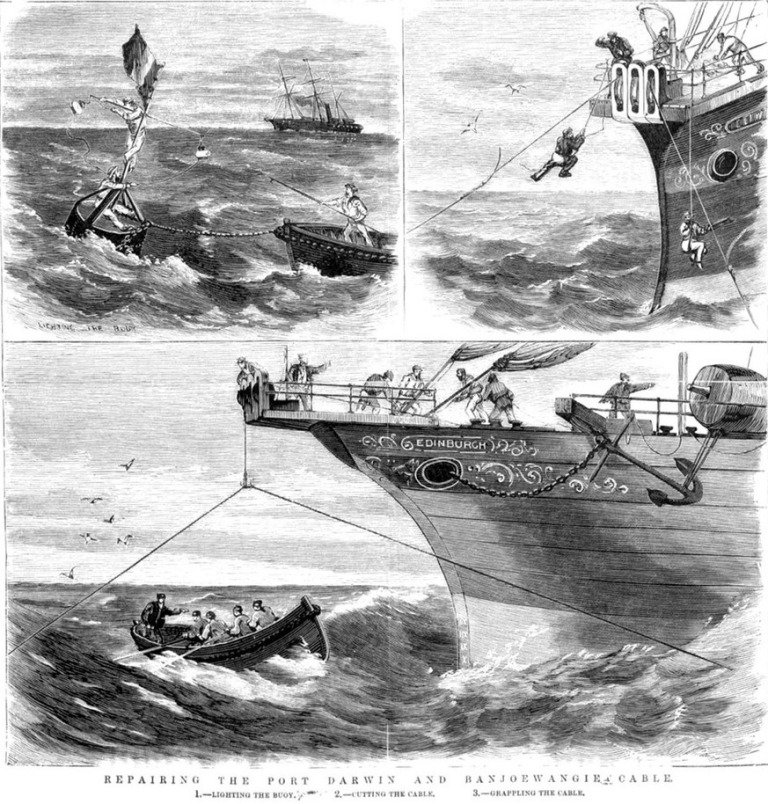
Repairing the Port Darwin and Banjoewangie cable, IAN29/11/76/193 from Australian Sketcher 1876, courtesy State Library of Victoria
Edward Cracknell (1831 – 14 January 1893) was New South Wales superintendent of telegraphs. Cracknell was born at Rochester, England, and educated at the University of Oxford. He came to Adelaide as Assistant Superintendent of Telegraphs with Charles Todd in November 1855, and became Assistant Superintendent of Telegraphs, New South Wales, in January 1858, opening the first telegraph line to Liverpool on the 26th of that month.[2]In 1861 he became Superintendent of Telegraphs. In 1876 he studied torpedo warfare, and was lieut.-colonel commanding the N.S.W. Torpedo and Signalling Corps. His younger brother, William John Cracknell, was for many years Superintendent of Telegraphs in Queensland.
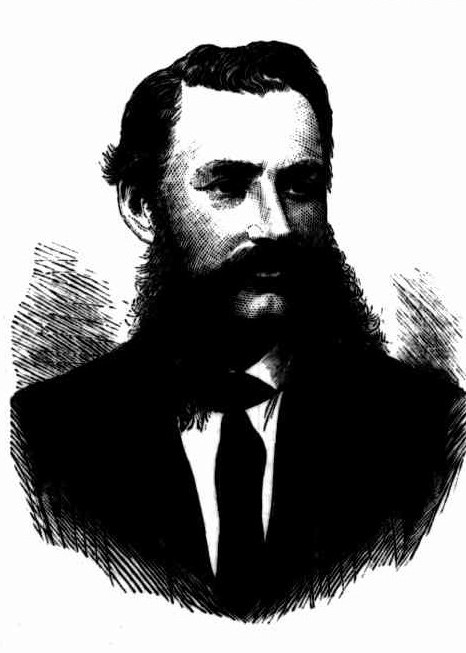 Cracknell's other great interest was the scientific side of military
operations. He thought the harbour could best be defended by fixed torpedoes
(underwater mines). He exploded the first torpedo in the colony at South
Head in 1871, and was gazetted a lieutenant in the Torpedo Corps, then part of
the Naval Brigade. He again visited England in 1876 and with the permission of
the Admiralty and War Office examined all their torpedo installations and
witnessed experiments. On his return he prepared a complete torpedo defence
system for Sydney, Newcastle and Botany Bay and it was approved by the military
authorities and the government. In 1880-81 he published three confidential
lectures which he had given in Sydney on torpedoes. When his unit was
transferred to the military forces and renamed the Submarine Miners Corps in
1877, Cracknell was promoted major. In 1881 in evidence to the royal commission
on the colony's defences he explained that the corps was largely made up of
signallers and electricians from the Telegraph Department and that he ran it as
closely as possible in connexion with that department.
Cracknell's other great interest was the scientific side of military
operations. He thought the harbour could best be defended by fixed torpedoes
(underwater mines). He exploded the first torpedo in the colony at South
Head in 1871, and was gazetted a lieutenant in the Torpedo Corps, then part of
the Naval Brigade. He again visited England in 1876 and with the permission of
the Admiralty and War Office examined all their torpedo installations and
witnessed experiments. On his return he prepared a complete torpedo defence
system for Sydney, Newcastle and Botany Bay and it was approved by the military
authorities and the government. In 1880-81 he published three confidential
lectures which he had given in Sydney on torpedoes. When his unit was
transferred to the military forces and renamed the Submarine Miners Corps in
1877, Cracknell was promoted major. In 1881 in evidence to the royal commission
on the colony's defences he explained that the corps was largely made up of
signallers and electricians from the Telegraph Department and that he ran it as
closely as possible in connexion with that department.
As early as 1874 Cracknell had lectured to the Royal Society of New South Wales on 'Duplex Telegraphy' and on his return from the International Telegraphic Convention in Berlin in 1885 he introduced the duplex and quadruplex systems and modernized the telegraphic service. He was also interested in the uses of electric lighting. In 1886 he was gazetted lieutenant-colonel.
Above portrait of Edward Charles Cracknell from: [No heading]. (1878, November 23). Australian Town and Country Journal (Sydney, NSW : 1870 - 1907), p. 17. Retrieved from http://nla.gov.au/nla.news-page5668935
Cracknell was a member of the Institution of Civil Engineers and Electrical Engineers in England, of the Royal Society of New South Wales from 1865 and of the Engineering Association of New South Wales from 1879. He was a founder and first president of Sydney's Electric Club about 1891. By 1893 the colony had 22,000 miles (35,405 km) of telegraph lines and 600 stations, and Cracknell had been responsible for the high standard of the equipment used. When the zigzag railway across the Blue Mountains was being built, Cracknell managed to shift 80,000 tons of rock with two different blasts. He died on 14 January 1893 at his home, Richmond, Edgecliffe Road, Woollahra, after 'over-exertion during an all day parade', and was buried in the Anglican section of Waverley cemetery. He was survived by his wife Margaret, née Cunningham, whom he had married in Rochester about 1853, and by his only son and three of his five daughters. An obituarist claimed that Cracknell's 'heart was thoroughly in his work', and that his zeal was 'equalled by his natural intelligence and acquired capacity'.
J. L. Affleck and Martha Rutledge, 'Cracknell, Edward Charles (1831–1893)', Australian Dictionary of Biography, National Centre of Biography, Australian National University, http://adb.anu.edu.au/biography/cracknell-edward-charles-3283/text4985, published in hardcopy 1969
1878: Following the invention of the telephone, several long-distance transmission experiments are successfully conducted in Australia, at distances of up to 400 km.
1880: Only two years after the first exchange in the world is built, Australia's first telephone exchanges open in Melbourne and Brisbane, followed by Sydney in 1881.
1883: Exchanges open in Adelaide and Hobart, the Perth exchange opens in 1887.
Professor Graham Bell, of Brantford, Canada, has succeeded in constructing an instrument by which the tones of the human voice may be transmitted to a long distance by means of electricity. On reading the account we were disposed at first to discredit the whole affair; but Professor Bell's scientific reputation prevents us from calling his statements in question. The apparatus consists of telephones constructed of goldbeaters' skin placed in electrical connection with each other by means of electro-magnets and wires in the ordinary way. The telephone is, as its name implies, an instrument for conveying sound to a distance. It usually consists of two membranes stretched on wooden frames somewhat after the manner of a drum-head and connected together with metal wires. Its original inventor was Reis, of Frankfort, who found that when a person spoke directing the voice to the inner surface of one of the membranes the sound was conveyed along the wires to the other membrane so as to be audible at a much greater distance than would otherwise have been the case. One of the telephones was placed by placed by Professor Bell in the room where the spectators were assembled, the other in a room on the basement floor of the house, The words spoken by a person at the telephone in tho basement were repeated audibly by the telephone in the other room, except that the vowel sounds alone were very clearly repeated, the consonants being scarcely recognisable. Sometimes, however, the Professor states a sentence came out with the most startling distinctness. Carrying out his investigations, Professor Bell has succeeded in transmitting the sounds of the human voice to a distance of five miles along the ordinary telegraph lines by means of the telephone. The discovery is certainly a very remarkable one, and may possibly be destined to work a considerable revolution in telegraphy. NOTES ON SCIENCE. (1876, November 6). South Australian Register (Adelaide, SA : 1839 - 1900), p. 4. Retrieved from http://nla.gov.au/nla.news-article43006216
We learn that the subscribers to the Telephone Exchange are about to enjoy an additional advantage in being furnished with the latest shipping news by telephone upon enquiry from the exchange clerk. INTERCOLONIAL CRICKET MATCH. (1881, February 22). The Brisbane Courier (Qld. : 1864 - 1933), p. 3. Retrieved from http://nla.gov.au/nla.news-article919012
%20barrenjoey%201914.jpg?timestamp=1399139607948)
Barren Joey Lighthouse (Burrin Ju) [picture].Housed in a postcard album. Written on the inside of the front cover: June 1914. Photo's taken in New South Wales & Queensland by A. J. Vogan Esq. Special Correspondent of the Illustrated London News at the time of the Eruption in New Zealand. View looking from a path, past rocks on the left, to the lighthouse behind. Image No.: H82.254/8/34 courtesy State Library of Victoria
From Telegraphs to Telephones - For All Ships at Sea and Those On Land - threads collected and collated by A J Guesdon, 2014.